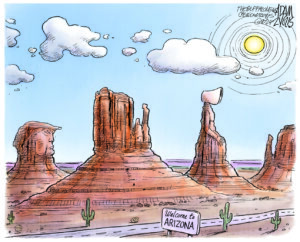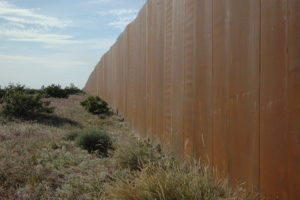Border Wars in the Homeland
Shena Gutierrez was already cuffed and in an inspection room in Nogales, Ariz., when the Customs and Border Protection agent grabbed her purse, opened it, dumped its contents onto the floor, and began to trample on her life, quite literally, with his black boots. 1
2
3
4
1
2
3
4
Shena Gutierrez was already cuffed and in an inspection room in Nogales, Arizona, when the Customs and Border Protection (CBP) agent grabbed her purse, opened it, and dumped its contents onto the floor right in front of her. There couldn’t be a sharper image of the Bill of Rights rollback we are experiencing in the U.S. borderlands in the post-9/11 era.
Tumbling out of that purse came Gutierrez’s life: photos of her kids, business cards, credit cards, and other papers, all now open to the official scrutiny of the Department of Homeland Security. There were also photographs of her husband, Jose Gutierrez Guzman, whom CBP agents beat so badly in 2011 that he suffered permanent brain damage. The supervisory agent, whose name badge on his blue uniform read “Gomez,” now began to trample on her life, quite literally, with his black boots.
“Please stop stepping on the pictures,” Shena asked him.
A U.S. citizen, unlike her husband, she had been returning from a 48-hour vigil against Border Patrol violence in Mexico and was wearing a shirt that said “Stop Border Patrol Brutality” when she was aggressively questioned and cuffed at the CBP’s “port of entry” in Nogales on that hot day in May. She had no doubt that Gomez was stepping all over the contents of her purse in response to her shirt, the evidence of her activism.
Perhaps what bothered Gomez was the photo silkscreened onto that shirt — of her husband during his hospitalization. It showed the aftermath of a beating he received from CBP agents. His head had a partially caved-in look because doctors had removed part of his skull. Over his chest and arms were bruises from Tasering. One tooth was out of place, and he had two black eyes. Although you couldn’t see them in the photo, two heavily armed Homeland Security agents were then guarding his hospital door to prevent the father of two, formerly a sound technician and the lead singer of a popular band in Los Angeles, from escaping — even in his comatose state.
Jose Gutierrez Guzman’s has become an ever more common story in an American age of mass expulsions. Although he had grown up in the United States (without papers), he was born in Mexico. After receiving a letter requesting his appearance, he went to the Immigration and Customs Enforcement building in Los Angeles and was promptly arrested and deported. Customs and Border Protection agents later caught him crossing the border in San Luis, Arizona, near Yuma, in an attempt to reunite with his wife and children.
“Stop… stepping… on… the… pictures,” Shena insisted.
As she tells the story, Agent Gomez looked at her shirt for a second, then looked up at her and said, “You have that mentality about us. You think we go around abusing.” His tone remained faux-friendly, but his boots didn’t — and neither did those cuffs another CBP agent had put on her. Forcing her hands behind her back, they cut uncomfortably into her wrists. They would leave deep red circular marks.
On display was a post-9/11 world in which the usual rights meant to protect Americans from unreasonable search and seizure and unwanted, as well as unwarranted, interrogation were up for grabs.
While such constitutionally questionable intrusions into people’s privacy have been increasing at border crossings in the post-9/11 years, this type of hardline border policing has also moved inland. In other words, the sort of intrusions that once would have qualified as unconstitutional have moved in startling numbers into the interior of the country.
Imagine the once thin borderline of the American past as an ever-thickening band, now extending 100 miles inland around the United States — along the 2,000-mile southern border, the 4,000-mile northern border, and both coasts — and you will be able to visualize how vast the CBP’s jurisdiction has become. This “border” region now covers places where two-thirds of the U.S. population (197.4 million people) live. The ACLU has come to call it a “constitution-free zone.” The “border” has by now devoured the full states of Maine and Florida and much of Michigan.
In these vast domains, Homeland Security authorities can institute roving patrols with broad, extra-constitutional powers backed by national security, immigration enforcement, and drug interdiction mandates. There, the Border Patrol can set up traffic checkpoints and fly surveillance drones overhead with high-powered cameras and radar that can track your movements. Within 25 miles of the international boundary, CBP agents can enter a person’s private property without a warrant. In these areas, the Homeland Security state is anything but abstract. On any given day, it can stand between you and the grocery store.
“Border Patrol checkpoints and roving patrols are the physical world equivalent of the National Security Agency,” says attorney James Lyall of ACLU Arizona puts it. “They involve a massive dragnet and stopping and monitoring of innocent Americans without any suspicion of wrongdoing by increasingly abusive and unaccountable federal government agents.”
Before she was so unceremoniously stopped and held, Shena Gutierrez shared the story of her husband at that 48-hour vigil. It was another story of the kind of pervasive abuse reported by people in the 100-mile zone. There were no cameras that night to record how 11 agents “subdued” Jose Gutierrez Guzman, as the CBP put it in its official report on the incident. Its claim: that Jose “struck his head on the ground,” a way perhaps of accounting for the hospital’s eventual diagnosis of “blunt force trauma.”
Considering the extent of Jose’s injuries, that CBP report is questionable indeed. Many Border Patrol agents now use the term “tonk” — the sound a flashlight supposedly makes when it bangs against someone’s head — as their way of describing border-crossers. Jose was also repeatedly “shot” with an “electronic control device,” aka a Taser. He was so badly beaten that, more than three years later, he still suffers seizures.
Your support matters…Independent journalism is under threat and overshadowed by heavily funded mainstream media.
You can help level the playing field. Become a member.
Your tax-deductible contribution keeps us digging beneath the headlines to give you thought-provoking, investigative reporting and analysis that unearths what's really happening- without compromise.
Give today to support our courageous, independent journalists.






You need to be a supporter to comment.
There are currently no responses to this article.
Be the first to respond.